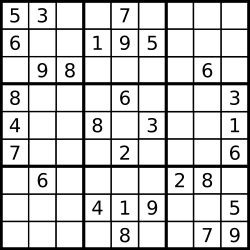Write a program to solve a Sudoku puzzle by filling the empty cells.
Empty cells are indicated by the character '.'.
You may assume that there will be only one unique solution.

A sudoku puzzle...

This problem is M^9 complexity m is the number of empty slots.
we can use DFS to solve this problem with backtracking.
class Solution:
# @param board, a 9x9 2D array
# Solve the Sudoku by modifying the input board in-place.
# Do not return any value.
def check(self, x, y, board):
tmp = board[x][y]
board[x][y] = '.'
for row in range(9):
if board[row][y] == tmp:
return False
for col in range(9):
if board[x][col] == tmp:
return False
for row in range(3):
for col in range(3):
if board[(x / 3) * 3 + row][(y / 3) * 3 + col] == tmp:
return False
board[x][y] = tmp
return True
def dfs(self, board):
for row in range(9):
for col in range(9):
if board[row][col] == '.':
for char in '123456789':
board[row][col] = char
if self.check(row, col, board) and self.dfs(board):
return True
board[row][col] = '.'
return False
return True
def solveSudoku(self, board):
self.dfs(board)





 本文介绍了一种使用深度优先搜索(DFS)与回溯法解决数独问题的方法。通过检查每一空位是否能放置1到9之间的数字,并递归地进行验证,确保最终解决方案的唯一性和正确性。
本文介绍了一种使用深度优先搜索(DFS)与回溯法解决数独问题的方法。通过检查每一空位是否能放置1到9之间的数字,并递归地进行验证,确保最终解决方案的唯一性和正确性。
















 556
556

 被折叠的 条评论
为什么被折叠?
被折叠的 条评论
为什么被折叠?








